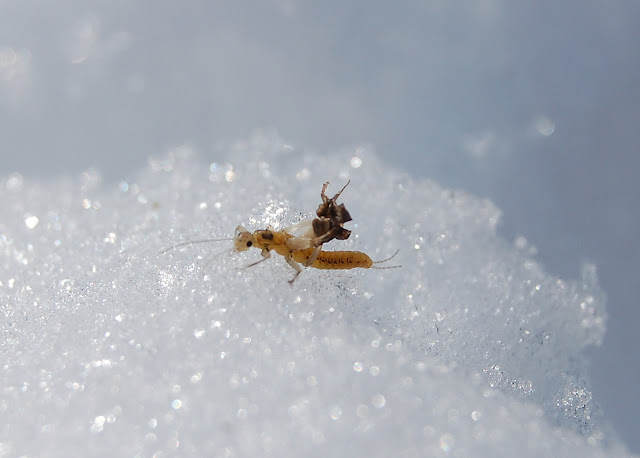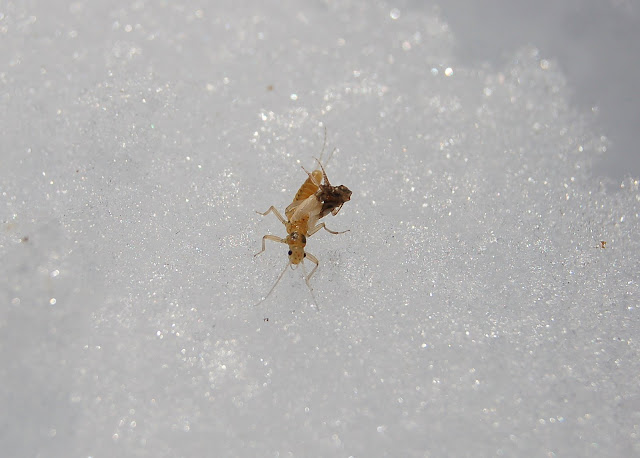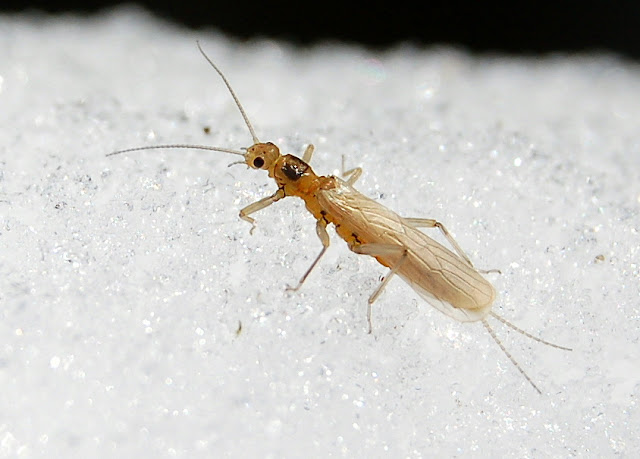
Salmonflies
Pteronarcys californica
The giant Salmonflies of the Western mountains are legendary for their proclivity to elicit consistent dry-fly action and ferocious strikes.
Featured on the forum

This specimen appears to be of the same species as this one collected in the same spot two months earlier. The identification of both is tentative. This one suffered some physical damage before being photographed, too, so the colors aren't totally natural. I was mostly photographing it to test out some new camera setting idea, which worked really well for a couple of closeups.

Troutnut is a project started in 2003 by salmonid ecologist Jason "Troutnut" Neuswanger to help anglers and
fly tyers unabashedly embrace the entomological side of the sport. Learn more about Troutnut or
support the project for an enhanced experience here.
Patcrisci on Feb 20, 2009February 20th, 2009, 4:04 am EST
I've noticed over the last few years quite a number of fly patterns tied and fished to imitate "crippled" insects. These, I'm guessing would imitate insects that are ill-formed, weak, unable to escape the nymphal shuck, injured, etc. These insects it seems are exactly the sort of "free meals" that predators lock in on and take readily because they are easy pickings. We've all seen the TV show where the weak or wounded zebra ends up as prey -- and I guess it's the same for trout and cripples. Trout look for easy prey. Anyone know the history -- the who, what, when, where and how the idea to tie and fish "cripples" came about? Do you have a favorite "cripple" pattern?
Pat Crisci
Martinlf on Feb 20, 2009February 20th, 2009, 7:35 am EST
I believe it was Rene Harrop who said cripples work on the same principle expressed in the clause, "a man can't run very fast with his pants down around his ankles." Now I don't know if interrupted escapades with married women (his own experiences, or reported ones) led him to this metaphor, but insects that are stuck in the shuck are, as you indicate, easy prey. Harrop has based a number of his transitional patterns on this idea, and Kelly Galloup's book, Cripples and Spinners has some neat patterns. The pattern I tied for the fly swap is in essence a cripple. I'll try to bump up the thread. I'd bet you can find some of Harrop's patterns with a Google search.
"He spread them a yard and a half. 'And every one that got away is this big.'"
--Fred Chappell
--Fred Chappell
Patcrisci on Feb 20, 2009February 20th, 2009, 8:17 am EST
Hi Fred,
Thank you for the references to Harrop and Galloup, I'll check them out. I'd love to see your cripple pattern too. While we're on the subject, I am trying to get up to speed on tying cripples. I notice that the shuck material is often z-lon or antron. Are there other shuck materials too? What are the advantages of each? What about color -- are all shucks the same color?
Thank you for the references to Harrop and Galloup, I'll check them out. I'd love to see your cripple pattern too. While we're on the subject, I am trying to get up to speed on tying cripples. I notice that the shuck material is often z-lon or antron. Are there other shuck materials too? What are the advantages of each? What about color -- are all shucks the same color?
Pat Crisci
JAD on Feb 20, 2009February 20th, 2009, 10:11 am EST
Now I know why I catch the fish I do, -The fish take one look of me and they know I'm not working with a full deck.
For types of shucks ,I think you can use almost anything that matches the colour of the nymph body. I used to use old nylon hose( when I could lay my hands on them) their it is again .:)
You ask--(advantages of each?) any time you can lay your hands on nylons-theirs always an up side.
Regards
JAD
For types of shucks ,I think you can use almost anything that matches the colour of the nymph body. I used to use old nylon hose( when I could lay my hands on them) their it is again .:)
You ask--(advantages of each?) any time you can lay your hands on nylons-theirs always an up side.
Regards
JAD
They fasten red (crimson red) wool around a hook, and fix onto the wool two feathers which grow under a cock’s wattles, and which in colour are like wax.
Radcliffe's Fishing from the Earliest Times,
Falsifly on Feb 20, 2009February 20th, 2009, 1:53 pm EST
JAD
JAD,
The last time Jack and I were at the bar I tried to lay my hands on some nylons. Let me tell ya, there was no up side. I’m now getting around on crutches.
Pat,
I hope you will forgive me for straying off the subject; what was it, oh ya cripples.
any time you can lay your hands on nylons-theirs always an up side.
JAD,
The last time Jack and I were at the bar I tried to lay my hands on some nylons. Let me tell ya, there was no up side. I’m now getting around on crutches.
Pat,
I hope you will forgive me for straying off the subject; what was it, oh ya cripples.
Falsifly
When asked what I just caught that monster on I showed him. He put on his magnifiers and said, "I can't believe they can see that."
When asked what I just caught that monster on I showed him. He put on his magnifiers and said, "I can't believe they can see that."
Patcrisci on Feb 21, 2009February 21st, 2009, 2:46 am EST
You guys are too funny! Hey, here's what I'm thinking... the fish take one look at my floating abominations (I dare call them flies) and say "whoa, what's that??? Looks like nothing I've ever seen." Things that come from my vise often look like they were tied in the dark with one hand tied behind my back. Ha! Anyway, so the shuck color and body color should match... is that the idea? Are there any natural hairs or furs that make good shuck material?
Pat Crisci
CaseyP on Feb 21, 2009February 21st, 2009, 6:05 am EST
Are there any natural hairs or furs that make good shuck material?
well, actually, antron yarn is great because it has the plasticky sparkle of the real thing. bug shuck is translucent and tough, kind of like thin fingernail. when it's shed, it crumples up like kitchen plastic wrap. the yarn duplicates this wrinkled aspect, with its little points of reflected light. you could try wool, but it might not sparkle quite so much.
and when your duns are done, you can use the antron yarn to make handy, adjustable indicators, which will use up your otherwise-lifetime-supply of yarn
"You can observe a lot by watching." Yogi Berra
JOHNW on Feb 21, 2009February 21st, 2009, 7:01 am EST
Pat
Are there any natural hairs or furs that make good shuck material?
I have come to use barred mallard or wood flank on my smaller flies.
Bob Quigley reccomends the use of appropriately colored marabou filaments.
A key point for any shuck IMHO is to keep it very sparse. If you ever get the chance to skim the surface with a small sein during a hatch you will be amazed how fine the shucks really are.
Are there any natural hairs or furs that make good shuck material?
I have come to use barred mallard or wood flank on my smaller flies.
Bob Quigley reccomends the use of appropriately colored marabou filaments.
A key point for any shuck IMHO is to keep it very sparse. If you ever get the chance to skim the surface with a small sein during a hatch you will be amazed how fine the shucks really are.
"old habits are hard to kill once you have gray in your beard" -Old Red Barn
Martinlf on Feb 21, 2009February 21st, 2009, 7:08 am EST
Pat, I like CDC for some shucks. It floats, but gets damp enough to sit in the film. Paul Weamer uses Mink Guard hair on some patterns. There are many possibilities, just be careful if you try to lay your hands on nylons. I hear Falsifly chose the wrong pair to reach for and got laid up. I think Jack was egging him on, though, so if you don't keep company with him you may not make the same mistake.
Oh, and to clarify, I'm not Fred. Fred Chappell is one of my favorite writers. That's a quotation from one of his books below.
I'm Louis
Oh, and to clarify, I'm not Fred. Fred Chappell is one of my favorite writers. That's a quotation from one of his books below.
I'm Louis
"He spread them a yard and a half. 'And every one that got away is this big.'"
--Fred Chappell
--Fred Chappell
JAD on Feb 21, 2009February 21st, 2009, 10:27 am EST
I don't know Louis I kind of like calling you Fred.
JAD
JAD
They fasten red (crimson red) wool around a hook, and fix onto the wool two feathers which grow under a cock’s wattles, and which in colour are like wax.
Radcliffe's Fishing from the Earliest Times,
JOHNW on Feb 21, 2009February 21st, 2009, 10:42 am EST
JAD,
I'm starting to wonder about our kind professor friend. He has at least 3 aliases that I know of and the list is growing.
I guess it is OK as long as that murderous fellow Ol' Black Toe doesn't show up right when cicadas start hitting the water.
jw
I'm starting to wonder about our kind professor friend. He has at least 3 aliases that I know of and the list is growing.
I guess it is OK as long as that murderous fellow Ol' Black Toe doesn't show up right when cicadas start hitting the water.
jw
"old habits are hard to kill once you have gray in your beard" -Old Red Barn
Patcrisci on Feb 21, 2009February 21st, 2009, 12:36 pm EST
Thanks to all for your responses to my shucking questions. I've decided to go with antron. Do I need a different shade to match the body color of each fly? Or can I get by with a light, middling, and dark shade, ala Atherton's nymphs?
Chip Drozenski uses just thread and CDC to tie his cripples. If you Google his name "Chip Drozenski" you will see photos of his work. He lives in North Carolina but fishes (and has for years) on the Delaware River in NY and PA.
Chip Drozenski uses just thread and CDC to tie his cripples. If you Google his name "Chip Drozenski" you will see photos of his work. He lives in North Carolina but fishes (and has for years) on the Delaware River in NY and PA.
Pat Crisci
Martinlf on Feb 21, 2009February 21st, 2009, 4:08 pm EST
Pat, I match my shucks to the nymph color, so they are typically darker and a different color from the body. For example, for hendricksons while the body is pinkish tan (females) or reddish brown (males) I'll use a dark brown or dark olive brown shuck, and for dorthea sulphurs, which I tie with yellow bodies, I'll use a tan shuck.
--Ol' Black Toe
(John and John are having a little fun at my expense, something you'll have to endure--as I do. They are referring to a day I showed up on the Little Juniata River with a purplish black middle toe, having been bitten by a spider or something while I was scouting my favorite riffle in sandals. We debated whether I should fish or go to the doctor.
I fished.
The toe returned to its normal color in a day or so.)
--Ol' Black Toe
(John and John are having a little fun at my expense, something you'll have to endure--as I do. They are referring to a day I showed up on the Little Juniata River with a purplish black middle toe, having been bitten by a spider or something while I was scouting my favorite riffle in sandals. We debated whether I should fish or go to the doctor.
I fished.
The toe returned to its normal color in a day or so.)
"He spread them a yard and a half. 'And every one that got away is this big.'"
--Fred Chappell
--Fred Chappell
JAD on Feb 22, 2009February 22nd, 2009, 2:50 am EST
I'm innocent ---just because I said---(I don't know Louis I kind of like calling you Fred.) John W is the real trouble maker.
The other John
The other John
They fasten red (crimson red) wool around a hook, and fix onto the wool two feathers which grow under a cock’s wattles, and which in colour are like wax.
Radcliffe's Fishing from the Earliest Times,
Martinlf on Feb 22, 2009February 22nd, 2009, 2:58 am EST
JAD, you know they say, "the guilty dog barks first."
"He spread them a yard and a half. 'And every one that got away is this big.'"
--Fred Chappell
--Fred Chappell
Patcrisci on Feb 22, 2009February 22nd, 2009, 3:58 am EST
John, John, and OBT,
I love it. Sounds like you guys are fishing partners. There are so many great stories that came from fishing trips with fishing buddies.
Your story reminds me of a Fourth of July fishing trip with "Tommy the half-breed." It was early, before sunup, and Tommy, half-Cherokee and half second-generation German, was already whistling casts past my ear and his.
We were in a small jon-boat on a resevoir in NY, flycasting for smallmouth bass. Tommy promptly pierced his left ear with a number four deerhair mouse. Clean through the lobe. It made him look even scarier than he normally does -- a 280-pounder with a permanent scowl and the disposition of a badger.
Tommy, however, was unfazed, having thoroughly exercised his right elbow lifting and throwing back whiskies and chasing them with pilseners long into the night.
Well, after a healthy ration of good-natured ribbing, I reached into a vest pocket, produced a needle nose plier/wire cutter, snipped the big hook past the barb and slipped the mouse free. We fished out the morning and left.
That's how "Tommy the half breed" got his ear pierced.
I love it. Sounds like you guys are fishing partners. There are so many great stories that came from fishing trips with fishing buddies.
Your story reminds me of a Fourth of July fishing trip with "Tommy the half-breed." It was early, before sunup, and Tommy, half-Cherokee and half second-generation German, was already whistling casts past my ear and his.
We were in a small jon-boat on a resevoir in NY, flycasting for smallmouth bass. Tommy promptly pierced his left ear with a number four deerhair mouse. Clean through the lobe. It made him look even scarier than he normally does -- a 280-pounder with a permanent scowl and the disposition of a badger.
Tommy, however, was unfazed, having thoroughly exercised his right elbow lifting and throwing back whiskies and chasing them with pilseners long into the night.
Well, after a healthy ration of good-natured ribbing, I reached into a vest pocket, produced a needle nose plier/wire cutter, snipped the big hook past the barb and slipped the mouse free. We fished out the morning and left.
That's how "Tommy the half breed" got his ear pierced.
Pat Crisci
JAD on Feb 22, 2009February 22nd, 2009, 7:42 am EST
Hay Pat your right Louis (Fred) ended up with the best of the deal.
After all he has two --good looking -smart - accomplished-fisherman to learn from. Louis does tell great jokes though I dont think he goes for piercing .:)
JAD
After all he has two --good looking -smart - accomplished-fisherman to learn from. Louis does tell great jokes though I dont think he goes for piercing .:)
JAD
They fasten red (crimson red) wool around a hook, and fix onto the wool two feathers which grow under a cock’s wattles, and which in colour are like wax.
Radcliffe's Fishing from the Earliest Times,
Patcrisci on Feb 28, 2009February 28th, 2009, 9:02 am EST
Thanks to lfmartin for turning me on to Kelly Galloups spent cripples. I'm gonna tie some up and try em out.
http://www.flyfisherman.com/ftb/kgcripple/index.html
http://www.flyfisherman.com/ftb/kgcripple/index.html
Pat Crisci
DOS on Feb 28, 2009February 28th, 2009, 9:14 am EST
Great topic guys!
Here is a neat picture i captured, of what I believe to be a "crippled" little yellow stonefly, of the Capnia genus. He was struggling in the surface film during a large hatch last week, here on a spring creek in upstate NY. Poor little guy was making quite a commotion ... attracting plenty of attention.
Speaking of surface film, it is my opinion that streams like a chalk/spring creek, with even and consistent, oil slick flows, are more likely to trap emerging aquatic insects when trying to break through the waters meniscus, than a typical freestone stream. And therefor, I really like to fish cripples when I find myself on such waterways. My hypothesis is purely anecdotal, but fishing cripples in these situations gives me great confidence!!


and a shot of one of his more healthy comrades

Here is a neat picture i captured, of what I believe to be a "crippled" little yellow stonefly, of the Capnia genus. He was struggling in the surface film during a large hatch last week, here on a spring creek in upstate NY. Poor little guy was making quite a commotion ... attracting plenty of attention.
Speaking of surface film, it is my opinion that streams like a chalk/spring creek, with even and consistent, oil slick flows, are more likely to trap emerging aquatic insects when trying to break through the waters meniscus, than a typical freestone stream. And therefor, I really like to fish cripples when I find myself on such waterways. My hypothesis is purely anecdotal, but fishing cripples in these situations gives me great confidence!!
and a shot of one of his more healthy comrades
Andrew Nisbet
Wbranch on Feb 28, 2009February 28th, 2009, 10:08 am EST
Terrific close-ups! Great job. What really constitutes a cripple? It appears that maybe the shuck would have come off if it had not gotten on the snow. Did you pick it up or did it crawl up onto the snow? I usually think of a cripple as a bug that is either laying over on it's side with the shuck still attached or floating upside down and just the head and a bit of thorax out of the nymphal skin.
Catskill fly fisher for fifty-five years.
Quick Reply
Related Discussions
Topic
Replies
Last Reply
3
Jan 16, 2007
by Martinlf
by Martinlf







